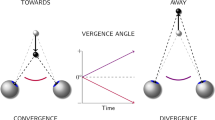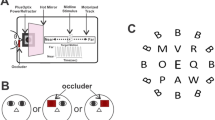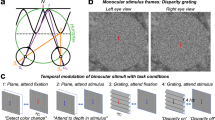Abstract
Primates use vergence eye movements to align their two eyes on the same object and can correct misalignments by sensing the difference in the positions of the two retinal images of the object (binocular disparity). When large random-dot patterns are viewed dichoptically and small binocular misalignments are suddenly imposed (disparity steps), corrective vergence eye movements are elicited at ultrashort latencies1,2. Here we show that the same steps applied to dense anticorrelated patterns, in which each black dot in one eye is matched to a white dot in the other eye, initiate vergence responses that are very similar, except that they are in the opposite direction. This sensitivity to the disparity of anticorrelated patterns is shared by many disparity-selective neurons in cortical area V1 (ref. 3), despite the fact that human subjects fail to perceive depth in such stimuli4,5. These dataindicate that the vergence eye movements initiated at ultrashort latencies result solely from locally matched binocular features, and derive their visual input from an early stage of cortical processing before the level at which depth percepts are elaborated.
This is a preview of subscription content, access via your institution
Access options
Subscribe to this journal
Receive 51 print issues and online access
$199.00 per year
only $3.90 per issue
Buy this article
- Purchase on Springer Link
- Instant access to full article PDF
Prices may be subject to local taxes which are calculated during checkout


Similar content being viewed by others
References
Busettini, C., Miles, F. A. & Krauzlis, R. J. Short-latency disparity vergence responses and their dependence on a prior saccadic eye movement. J. Neurophysiol. 75, 1392–1410 (1996).
Busettini, C., Miles, F. A. & Krauzlis, R. J. Short-latency disparity vergence responses in humans. Soc. Neurosci. Abstr. 20, 1403 (1994).
Cumming, B. G. & Parker, A. J. Responses of primary visual cortical neurons to binocular disparity without depth perception. Nature 389, 280–283 (1997).
Julesz, B. Binocular depth perception of computer-generated patterns. Bell System Tech. J. 39, 1125–1162 (1960).
Cogan, A. I., Lomakin, A. J. & Rossi, A. F. Depth in anticorrelated stereograms: Effects of spatial density and interocular delay. Vision Res. 33, 1959–1975 (1993).
Bishop, P. O. & Pettigrew, J. D. Neural mechanisms of binocular vision. Vision Res. 26, 1587–1600 (1986).
Ohzawa, I., DeAngelis, G. C. & Freeman, R. D. Stereoscopic depth discrimination in the visual cortex: neurons ideally suited as disparity detectors. Science 249, 1037–1041 (1990).
Qian, N. Computing stereo disparity and motion with known binocular properties. Neural Computat. 6, 390–404 (1994).
Parker, A. J. & Cumming, B. G. Local vs global stereoscopic matching in neurons of cortical area V1. Invest. Ophthalmol. Vis. Sci. 37, S424 (1996).
Collewijn, H. & Erkelens, C. J. in Eye Movements and their Role in Visual and Cognitive Processes(ed. Kowler, E.) 213–261 (Elsevier, Amsterdam, (1990).
Judge, S. J. in Vision and Visual Dysfunction, 8: Eye Movements(ed. Carpenter, R. H. S.) 157–172 (Macmillan, London, (1991).
Rashbass, C. & Westheimer, G. Disjunctive eye movements. J. Physiol. (Lond.) 159, 339–360 (1961).
Poggio, G. F. & Fischer, B. Binocular interaction and depth sensitivity in striate and prestriate cortex of behaving rhesus monkey. J. Neurophysiol. 40, 1392–1405 (1977).
Poggio, G. F. Mechanisms of stereopsis in monkey visual cortex. Cerebr. Cort. 5, 193–204 (1995).
Trotter, Y., Celebrini, S., Stricanne, B., Thorpe, S. & Imbert, M. Neural processing of stereopsis as a function of viewing distance in primate visual cortical area VI. J. Neurophysiol. 76, 2872–2885 (1996).
Mitchell, D. E. Properties of stimuli eliciting vergence eye movements and stereopsis. Vision Res. 10, 145–162 (1970).
Cumming, B. G. & Judge, S. J. Disparity-induced and blur-induced convergence eye movement and accommodation in the monkey. J. Neurophysiol. 55, 896–914 (1986).
Westheimer, G. & Mitchell, D. E. The sensory stimulus for disjunctive eye movements. Vision Res. 9, 749–755 (1969).
Regan, D., Erkelens, C. J. & Collewijn, H. Necessary conditions for the perception of motion in depth. Invest. Opthalmol. Vis. Sci. 27, 584–597 (1986).
Busettini, C., Miles, F. A., Schwarz, U. & Carl, J. R. Human ocular responses to translation of the observer and of the scene: dependence on viewing distance. Exp. Brain Res. 100, 484–494 (1994).
Fuchs, A. F. & Robinson, D. A. Amethod for measuring horizontal and vertical eye movement chronically in the monkey. J. Appl. Physiol. 21, 1068–1070 (1966).
Acknowledgements
G.S.M. was supported by La Fondation pour la Recherche Medicale (France).
Author information
Authors and Affiliations
Corresponding author
Rights and permissions
About this article
Cite this article
Masson, G., Busettini, C. & Miles, F. Vergence eye movements in response to binocular disparity without depth perception. Nature 389, 283–286 (1997). https://doi.org/10.1038/38496
Received:
Accepted:
Issue Date:
DOI: https://doi.org/10.1038/38496
This article is cited by
-
Relative contributions to vergence eye movements of two binocular cues for motion-in-depth
Scientific Reports (2019)
-
Binocular non-stereoscopic cues can deceive clinical tests of stereopsis
Scientific Reports (2019)
-
On the role of ocular torsion in binocular visual matching
Scientific Reports (2018)
-
Binocular disparity can augment the capacity of vision without affecting subjective experience of depth
Scientific Reports (2018)
-
Dressmakers show enhanced stereoscopic vision
Scientific Reports (2017)
Comments
By submitting a comment you agree to abide by our Terms and Community Guidelines. If you find something abusive or that does not comply with our terms or guidelines please flag it as inappropriate.



